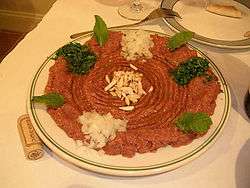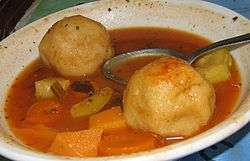Kibbeh
|
Fried kibbeh Raas (Nabulsi kibbeh) with peppermint | |
| Course | Meze or mezze /ˈmɛzeɪ/ |
|---|---|
| Region or state | Armenia, Brazil, Cyprus, Egypt, Iran, Iraq, Jordan, Israel, Lebanon, Palestine, Syria and Turkey |
| Serving temperature | Hot |
| Main ingredients | Finely ground meat, cracked wheat, and Middle Eastern spices |
|
| |
Kibbeh, kibbe, kebbah (also kubbeh, kubbah, kubbi) (pronunciation varies with region) (Arabic: كبة) is a Levantine dish[1] made of bulgur (cracked wheat), minced onions, and finely ground lean beef, lamb, goat, or camel meat with Middle Eastern spices (cinnamon, nutmeg, clove, allspice). The best-known variety is a torpedo-shaped fried croquette stuffed with cooked minced beef or lamb with onion and sautéed pine nuts.
Other types of kibbeh may be shaped into balls or patties, and baked, cooked in broth, or served raw.[2] Kibbeh is considered to be the national dish of many Middle Eastern countries.[3]
Kibbeh is a popular dish in Middle Eastern cuisine.[4] Mainly, it is found in Lebanon,[5] Syria,[6] Palestine, Jordan, Egypt (kubbeh, kebbah, or koubeiba),[7] Iraq,[8] as well as Armenia (ltsonvats kololak), Kurdistan, Iran,[9] Israel,[10] Cyprus (koupa, plural koupes), the Arabian Peninsula, in Kurdistan part of Turkey it's called içli köfte.[11]
It is also found throughout several Latin American countries which received substantial numbers of Levantine immigrants during the late 19th and early 20th centuries, including Argentina, Brazil, Colombia, Cuba, the Dominican Republic, Ecuador, Haiti, Honduras, and Mexico.[12]
Etymology
The word is derived from the Arabic kubbah or kibbeh, which means "ball".[13] Various transliterations of the name are used in different countries: in English, kibbe and kibbeh and in Latin America, quibe, kibe, or quipe (Argentina). Other names for the dish come either from the Persian word کوفته kofteh (see kofta), or from such as the Turkish içli köfte.
Variations
In Levantine cuisine, a variety of dishes made with bulghur (cracked wheat) and minced lamb are called kibbeh. The northern Syrian city of Aleppo (Halab) is famous for having more than 17 different types.[14] These include kibbeh prepared with sumac (kibbe sumāqiyye), yogurt (kibbe labaniyye), quince (kibbe safarjaliyye), lemon juice (kibbe ḥāmḍa), pomegranate sauce, cherry sauce, and other varieties, such as the "disk" kibbeh (kibbe arāṣ), the "plate" kibbeh (kibbe biṣfīḥa or kibbe bṣēniyye) and the raw kibbeh (kibbeh nayyeh).
One variety of kibbeh is kibbeh Raas or Nabulsi kubbeh in reference to the Palestinian city Nablus. It is a 7- to 15-cm-oblong bulghur shell shaped like an American football, stuffed with a filling of spiced, minced beef or lamb and fried until brown. British soldiers in the Middle East during the Second World War used to call these kibbeh "Syrian torpedoes".[15] It is similar in concept to the Sicilian arancini.
Fried, torpedo-shaped kibbe have become popular in Haiti, the Dominican Republic[16][17] and South America – where they are known as quipe or quibe – after they were introduced by Levantine immigrants.

Kibbeh nayyeh is a raw dish made from a mixture of bulghur, very finely minced lamb or beef similar to steak tartare, and Middle Eastern spices, served on a platter, frequently as part of a meze in Lebanon and Syria, garnished with mint leaves and olive oil, and served with green onions or scallions, green hot peppers, and pita/pocket bread or markouk bread. Palestinians prepare kibbeh nayyeh by adding ground lamb meat sauteed with onions and nuts on top of the meat and bulghur mixtxure.

Kibbeh b'Ssinniyeh or kibbeh bil sinieh (meaning kibbeh in a pan) (Arabic: كبّة بالصينيّة ) is commonly made of a mixture of finely ground lamb or beef, bulghur, onion, mint and Middle Eastern spices pressed into a flat baking pan. Normally, this dish consists of two layers (top and bottom) of the meat/cracked wheat mixture baked with a ground meat/onion/pine nut mix (hushwi) in between. Then it is scored with a knife into diamond shapes about one or two inches in length, topped with lightly sauteed pine nuts (snobar) or almond slivers and butter or olive oil, then baked in the oven until done. Extra butter/olive oil is then drained off and ready to serve.
Kubba Halab is an Iraqi version of kibbeh created with a rice crust and named after the largest city in Syria, Aleppo. Kubba Mosul, also Iraqi, is flat and round like a disc. Kubbat Shorba is an Iraqi-Kurdish version prepared as a stew, commonly made with tomato sauce and spices.[18] It is often served with arak and various salads. The Iraqi versions are part of the same versions eaten in Iran.[19] Kibbeh is sometimes served with a tahini dip. Brazilians, though, tend to add shoyu (Japanese fermented soy sauce), sometimes in addition to raw garlic, or Worcestershire or red chili pepper sauce, directly from the bottle. In Mexico, it is commonly found by the name kibis and sold by street merchants in the Yucatan Peninsula. This variation is commonly served with a sour tomato sauce, pickled cabbage, and red onions, or occasionally habanero peppers.
A Syrian soup known as kubbi kishk consists of kubbi "torpedoes" or "footballs" in a yogurt (kishk) and butter broth with stewed cabbage leaves.
In Israel, kubba matfuniya, kubba hamusta, kubba shwandar, and kubba bamia are soups with sauces and vegetables, or stews, served on rice. Kubba soup, served in many oriental restaurants in Israel and commonly at home, is described as a rich broth with vegetables and dumplings stuffed with meat. The fried variation in served with meze along with tahini, salads, falafel, and meat/fish dishes; it is also have a variations of adding concerted date, carob, or pomegranate juice, or adding dried raisins, dried apricots or hot chili peppers to the dish.

See also
References
| Wikimedia Commons has media related to Kibbeh. |
| Wikibooks Cookbook has a recipe/module on |
- ↑ Annia Ciezadlo (2012). Day of Honey: A Memoir of Food, Love, and War. p. 361. ISBN 1-4391-5753-7.
- ↑ Contemporary kubbeh
- ↑
- ↑ Middle Eastern Recipes
- ↑ Davidson et al. The Oxford Companion to Food OUP Oxford, 21 aug. 2014 ISBN 978-0191040726 pp 444-445
- ↑ Davidson et al. The Oxford Companion to Food OUP Oxford, 21 aug. 2014 ISBN 978-0191040726 pp 444-445
- ↑ Davidson et al. The Oxford Companion to Food OUP Oxford, 21 aug. 2014 ISBN 978-0191040726 pp 444-445
- ↑ Davidson et al. The Oxford Companion to Food OUP Oxford, 21 aug. 2014 ISBN 978-0191040726 pp 444-445
- ↑ Davidson et al. The Oxford Companion to Food OUP Oxford, 21 aug. 2014 ISBN 978-0191040726 pp 444-445
- ↑ Davidson et al. The Oxford Companion to Food OUP Oxford, 21 aug. 2014 ISBN 978-0191040726 pp 444-445
- ↑ Davidson et al. The Oxford Companion to Food OUP Oxford, 21 aug. 2014 ISBN 978-0191040726 pp 444-445
- ↑ "Kibbeh Recipe". Retrieved 26 February 2014.
- ↑ Maan Z. Madina, Arabic-English Dictionary of the Modern Literary Language, 1973
- ↑ "NPR web: Food Lovers Discover The Joys Of Aleppo".
- ↑ Kibbe, Pesach
- ↑ "Kibbeh - Arabic Comfort Food". Retrieved 26 February 2014.
- ↑ "Kibbeh". Retrieved 26 February 2014.
- ↑ Raw kibbeh
- ↑ Davidson et al. The Oxford Companion to Food OUP Oxford, 21 aug. 2014 ISBN 978-0191040726 p 44
